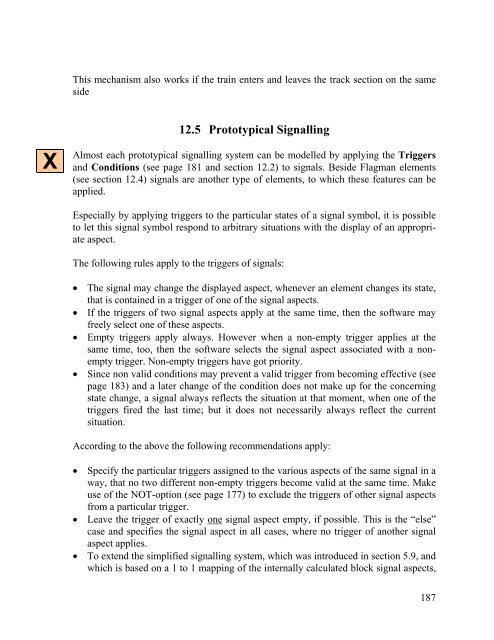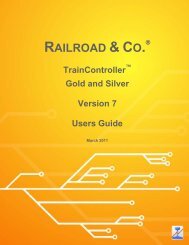Download - Freiwald Software
Download - Freiwald Software
Download - Freiwald Software
You also want an ePaper? Increase the reach of your titles
YUMPU automatically turns print PDFs into web optimized ePapers that Google loves.
X<br />
This mechanism also works if the train enters and leaves the track section on the same<br />
side<br />
12.5 Prototypical Signalling<br />
Almost each prototypical signalling system can be modelled by applying the Triggers<br />
and Conditions (see page 181 and section 12.2) to signals. Beside Flagman elements<br />
(see section 12.4) signals are another type of elements, to which these features can be<br />
applied.<br />
Especially by applying triggers to the particular states of a signal symbol, it is possible<br />
to let this signal symbol respond to arbitrary situations with the display of an appropriate<br />
aspect.<br />
The following rules apply to the triggers of signals:<br />
• The signal may change the displayed aspect, whenever an element changes its state,<br />
that is contained in a trigger of one of the signal aspects.<br />
• If the triggers of two signal aspects apply at the same time, then the software may<br />
freely select one of these aspects.<br />
• Empty triggers apply always. However when a non-empty trigger applies at the<br />
same time, too, then the software selects the signal aspect associated with a nonempty<br />
trigger. Non-empty triggers have got priority.<br />
• Since non valid conditions may prevent a valid trigger from becoming effective (see<br />
page 183) and a later change of the condition does not make up for the concerning<br />
state change, a signal always reflects the situation at that moment, when one of the<br />
triggers fired the last time; but it does not necessarily always reflect the current<br />
situation.<br />
According to the above the following recommendations apply:<br />
• Specify the particular triggers assigned to the various aspects of the same signal in a<br />
way, that no two different non-empty triggers become valid at the same time. Make<br />
use of the NOT-option (see page 177) to exclude the triggers of other signal aspects<br />
from a particular trigger.<br />
• Leave the trigger of exactly one signal aspect empty, if possible. This is the “else”<br />
case and specifies the signal aspect in all cases, where no trigger of another signal<br />
aspect applies.<br />
• To extend the simplified signalling system, which was introduced in section 5.9, and<br />
which is based on a 1 to 1 mapping of the internally calculated block signal aspects,<br />
187










